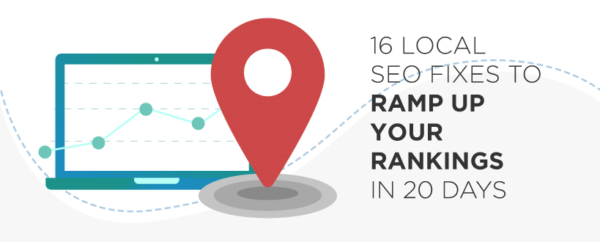
Local SEO has always been the saving grace of mom and pop stores when it comes to establishing their online presence. But, the local SEO landscape is changing at lightning fast speed. With Google reducing the Snack Pack to a three-pack and more ads eating the local results, local SEO is becoming a battleground for businesses that want to be relevant in their target area.
The best you can do is to keep on experimenting and adopting strategies until your site gets to that coveted position.
To give you a head start, we’ve compiled 16 local SEO fixes that will help you ramp up your ranking in 20 days.
Day 1 – 3
1. Speed Up Your Site
Site speed can make the difference between a bounce and a visit. 79% of customers are less likely to repeat a purchase from a site with low speed performance. To avoid this, you must:
- Reduce server response time to less than 200 milliseconds.
- Enable Gzip compression and browser cache.
- Optimize images with the right size, format, and image alt attribute.
- Remove unnecessary plugins or apps.
- Minify HTML, JavaScript, and CSS.
2. Optimize for Mobile-Friendliness
The split of Google’s mobile and desktop indexes sends one clear message: optimizing for different devices is not an option — it’s a must. If you want to keep your site at the top of both mobile and desktop search results, do the following:
- Set your viewport tag properly – don’t set it with a fixed width.
- Avoid using large pop-ups and overlays as this disrupts the user’s mobile experience.
- Focus on micro-moments, but do not strip down content to compromise.
- Test your site for mobile-friendliness – use Google’s Mobile-Friendly Test or Bing’s Mobile-Friendliness Test Tool.
3. Implement AMP
Between two pages that deliver the same content, users are likely to stay on the one that loads faster. This is why Google introduced the Accelerated Mobile Pages (AMP) to deliver a better experience to users. While this is not a ranking factor, the need of users to get information as fast as possible is what makes AMP relevant for websites.
- Install and activate the AMP WordPress plugin.
- Validate your pages using Chrome Developer Tools.
- Tweak the page attributes and the embed codes.
Day 4 – 8
4. Create Killer Content
Content will always be one of the pillars of any SEO strategy; 89% of B2B marketers use content marketing as part of their strategies. As the search landscape changes, how people look for and perceive content is also changing. Be prepared by doing the following:
- Update old content on your website; find keyword opportunities to rank your content.
- Use visuals such as videos and infographics that are relevant to your content to drive more engagement from your audience.
- Always build content for the user; match your content with their intent and the intent of the page.
- Write clear calls to action. Make sure users know what they’re getting from your site.
5. Implement Local Schema Markup
One of the things that businesses fail to do is setting their local schema markup properly. This takes away their opportunities to highlight the important parts of their site’s content.
- Don’t just go for the /LocalBusiness; choose a specific schema that best describes your business.
- Check if you have errors or missing field in your structured data markup – use the Structured Data Testing Tool from Google.
Day 9 – 11
6. Optimize Your Google My Business
Google local results are taking up more space than organic searches, and this means more opportunities to be in front of your target customers. But, the competition for the top spots can be just as fierce.
- Your NAP (Name, Address, and Phone Number) and business hours should be correct and consistent.
- Choose the appropriate category to list your business – be specific to your industry.
- Add photos of your business, give a virtual 360-degree tour, or include your payment methods.
- Manage and respond to reviews; interact with your customers.
7. Optimize Your Yahoo Local
While Google is leading the race in terms of getting more traffic, Yahoo is still a household name. Users in the U.S. and Canada still access Yahoo listings to get information about local businesses.
- Verify if your business listing is correct – this will take you to Yext PowerListings.
- Add a keyword-rich description and photos of your business.
- Encourage customers to leave reviews, and take the time in responding to their feedback with positive insights and solutions.
8. Optimize Your Bing Places for Business
Bing is one of the major data providers in the US, with 3.34 million search queries processed in Microsoft sites. Not optimizing your business for Bing takes away some of the opportunities to get more traffic.
- Your core business information must be correct and standardized – name, address, phone number, and business URL.
- Assign the right category/subcategory that fits into your business’ niche; you can select up to 10 categories.
9. Optimize Your Yellow Pages Profile
From last year’s reports, yellowpages.com gets 28% of visits to directory sites. While the traffic share is not as big as what you can get from Google My Business, yellowpages.com provided added reach and exposure to your target customers.
- Use videos or images to leave a lasting impression to your target audience .
- Optimize your profile with the right keywords; be specific to what your customer is searching for.
- Highlight what makes your business unique with a brief description.
10. Optimize Your Yelp and Manta Profile
Getting listed on Yelp and Manta provides your site with free traffic and added visibility. Claiming your business is quick and easy — why not use this to your advantage and optimize your Yelp and Manta profiles to get more visitors?
- Use keywords that your target audience will most likely type when they’re searching on directory sites or search engines. Get keyword ideas from Google Keyword Planner tool.
- Scatter your keywords in different sections, especially in the Product and Service Showcase pages of Manta.
- Include high-quality links – either a blog post or a service page from your site – to get these pages to rank higher in search results.
11. Use Localeze to Ensure Business Information Consistency
Submitting to directory sites is one thing, but making sure all the information you have on these sites is another story. Using Localeze helps you verify and manage information from different local listings.
- Get the True Identity service to ensure consistency on your local business listings.
- Re-verify your listings to keep them updated.
Day 12 – 14
12. Get users to review you
Statistics show that 68% of customers are likely to trust a business if they read a positive review about it. Reviews provide a strong driving force behind a customer’s purchasing decision. If customers are not sending their feedback, there’s something not right with your business.
- Use a strong call to action that encourages customers to leave a review on your site.
- Make it easy for them to leave a review or a star rating. There should only be one or two steps that customers have to take when leaving a review.
- Follow up with an email request for their review – it pays to be direct.
- Leverage products that rarely get reviews from customers; it won’t look natural if only a few products get all the reviews.
13. Get vouched for by local institutions
Authoritative links from local institutions can drive more than just traffic to your website. It helps your business gain credibility and shows how you’re getting connections from your local community.
- Get accredited by the Better Business Bureau (BBB). Getting a link as an accredited BBB business boosts your credibility and gives customers more reasons to trust your business.
- Start a scholarship. Get in touch with local universities in your area and send prospects details about your scholarship. Look for programs that are correlated or directly tied to your industry. For example, a digital marketing course would be a suitable scholarship offering for IT, marketing, and fields under digital studies.
- Be involved in your local community – host or be a sponsor in local charity events.
Day 15 – 20
14. Get on social media
Social media can complement your SEO in terms of getting more reach and improving the presence of your business. By combining a strong social presence with your SEO efforts, you can double the traffic that goes into your site.
- Identify your audience makeup – you should know who you’re targeting to align your strategies to their goals or preferences.
- Automate your social media process; use different tools such as Buffer and Hootsuite to streamline the process of scheduling posts and collecting data from your social media networks.
- Use keywords when you post on social media to make your content searchable.
15. Optimize your Facebook for maximum reach
By 2021, the number of Facebook users is expected to rise to 211.7 million. As the Facebook user base grows, so does the opportunities to get your business more presence.
- Use OpenGraph tags to improve the performance of your links on your Facebook page and provide structured data of your post, so every element – from your post title to the featured image – will be maximized for higher clickthrough.
- Use Domain Insights to know how your content is performing on your Facebook page. This shows you:
- Referral traffic coming from Facebook to your website
- The number of clicks on social buttons or plugins
- Demographic information
- Sharing metrics
- Referral traffic coming from Facebook to your website
16. Tap into your YouTube traffic
YouTube is the most popular video platform worldwide; it’s second to Google being the largest search engine in the world. By 2019, the estimated number of YouTube users will amount to 187.8 million. Using YouTube helps your business tap into another traffic source than local organic search.
- Use Google’s Keyword Planner tool to get keyword ideas that you can use for your YouTube videos. Use these keywords to optimize your video titles and descriptions.
- Make sure your channel has relevant information about your business; fill out your About page and include links to your website and social media sites.
- Overlay your videos with calls to action – but don’t overdo it. The key here is to soft sell; lead them to your website and provide them with value-added information that will make them purchase from you.
Changes are far from over. After all, you cannot fully predict what will happen next — you can only be prepared for it and ensure your business stays in top shape when these changes hit.
As part of providing a strong local SEO strategy, my company, SEOReseller.com recently launched a beta version of the Reputation Management Dashboard. Agencies and freelancers are invited to sign up for a free account and see how this can help them generate real reviews and monitor listings & mentions.
Digital & Social Articles on Business 2 Community(86)
Report Post



